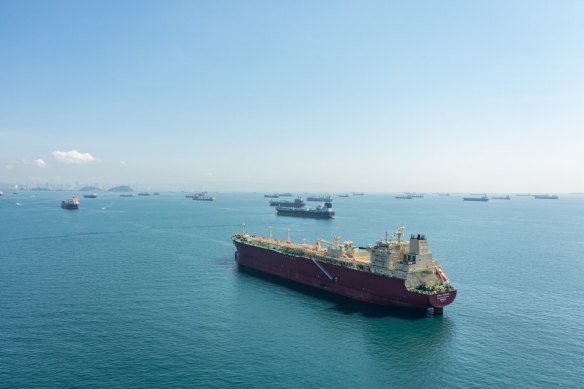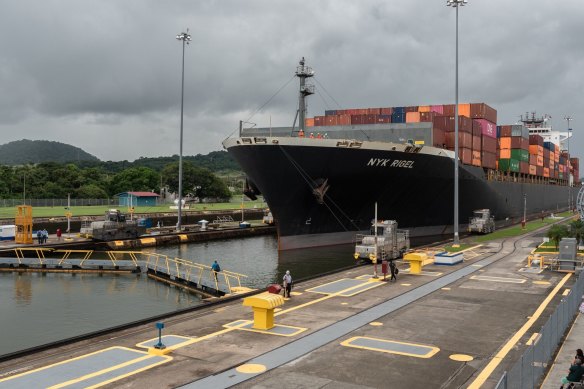This was published 1 year ago
Opinion
Why this photo is bad news for the global economy
Stephen Bartholomeusz
Senior business columnistThe conflict in the Middle East has the potential to increase the threat to global supply chains posed by the climate-related difficulties being experienced by one of the two major choke points in global trade.
With shipping being attacked in the Red Sea and Strait of Hormuz, insurance premiums for seaborne transport in the region are rising.

The queue of ships waiting to access the Panama Canal is building.Credit: Bloomberg
To date, there hasn’t been any threat or disruption to the operations of the Suez Canal, which handles about 15 per cent of global trade and 30 per cent of the world’s container traffic, but the threat level could rise if the war in Gaza were to develop into a wider regional conflict.
The Suez has become even more critical to global trade than in the past because the other big choke point, the Panama Canal, is experiencing drought-related (the Panamanians say climate change-related) challenges.
The canal, which provides a shortcut between the Atlantic and Pacific oceans, has the capacity to handle up to 38 ships a day via its complex system of locks, but Panama has cut the volume of ships it is allowing passage to 22 this month, with a planned reduction to 18 in February.
That’s because the lowest rainfalls since records started being kept in the 1950s – they are about 30 per cent below average this year – have reduced the water levels in the freshwater lakes that feed the canal and enable the locks’ operations. It takes about 190 million litres of fresh water to move a vessel through one of the canal’s locks, with only about 60 per cent of the water recovered.
Apart from reducing the volume of ships through the canal, the maximum draught of the ships allowed through it has been reduced from 50 feet to 44 feet, meaning a significant loss of capacity and increased costs.
Some shippers are redirecting their cargoes to US ports or lightening their loads by unloading containers, transporting across Panama by road or rail and then reloading them on the ships, adding delays and costs.
The queue of ships waiting to access the canal has been mounting, which has cost implications, and the premium for jumping the queue via the auctions Panama conducts for unscheduled capacity (mainly LNG and bulk commodity shipping) has seen shipping operators pay as much as $US4 million ($6 million) to secure a place. So far this year operators have paid more than $US235 million in premiums to use the canal.
The canal is a vital passage for trade between North America and Asia. The delays and restrictions on draught mean shipping is re-routed via Cape Horn, the southernmost tip of South America. There has been a significant increase in traffic via the Suez Canal.

It takes about 190 million litres of fresh water to move a vessel through one of the Panama Canal’s locks, with only about 60 per cent of the water recovered.Credit: Bloomberg
While container volumes have been largely unaffected (40 per cent of US container traffic uses the canal), dry bulk and LNG exports from the US to Asia – where Japan, South Korea and China are big buyers of American LNG – are under pressure.
There is a widening gap between LNG prices in Asia and Europe because of the reduced slots in the canal for ships as big as LNG carriers. Supply is being redirected to Europe, with Asian buyers forced to pay premiums to compete.
The combination of delays – re-routing ships through the Suez Canal adds about 10 days to a journey – the increased cost of accessing the canal, and the impact of the draught restrictions on the tonnages of products being shipped will impact global supply chains that had been functioning smoothly after recovering from the severe disruptions of the pandemic years.
Only last month the Federal Reserve Bank of New York published the latest reading from its global supply chain pressure index, which showed a continuation of this year’s fall in the index in October. The index, which measures the cost of transporting goods by sea, rail, truck and air, was at its lowest level since at least 1997.
The Baltic Dry Index, which measures the cost of shipping goods around the world, tells a somewhat different story.
From the last week of November, it has risen more than 80 per cent to its highest level since May last year, when there was a brief spike in the index.
It is now well above pre-pandemic levels. Disruptions and costs caused by the conflicts in the Middle East and Ukraine and the reduced capacity of the Panama Canal may be interacting with a pandemic-affected shortage of new shipping capacity.
Having only just recovered from the severe disruptions to global supply chains that the pandemic generated and which lead to decades-high inflation rates in most of the developed world’s economies, the last thing economic managers need, just as they are getting those inflation rates under control, is another bout of supply chain-induced inflation.
The reduction in the capacity of the Panama Canal is unlikely to be reversed any time soon, particularly as the El Nino climate pattern exacerbates the existing effects of the drought. If the lower rainfalls are a function of climate change, the reduction may, of course, be permanent.
That will make other routes, lengthier and more costly, increasingly important and increase the already significant role the Suez Canal plays with the global trading system.
It may also prompt the acceleration of plans to develop alternatives, although the most interesting – a multi-modal transport corridor that would open a sea leg between India and the United Arab Emirates and a rail link across the Arabian Peninsula to Israel’s port of Haifa, which would then ship the goods onto Europe – may well have been derailed by the war in Gaza.
The proposal, aired at the G20 Summit in New Delhi in September, requires co-operation between Israel and the Arab states. That would appear unlikely any time soon.
The Business Briefing newsletter delivers major stories, exclusive coverage and expert opinion. Sign up to get it every weekday morning.